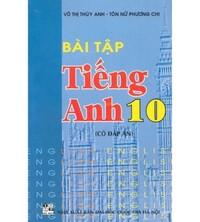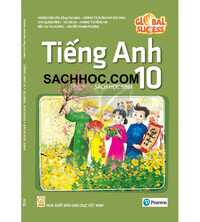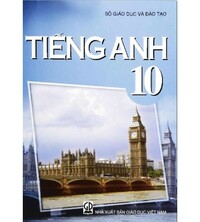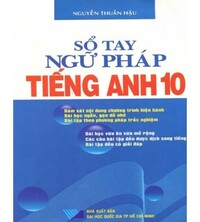Tiếng Anh 10 Unit 4 4.4 Reading
1. Look at the photos on pages 40–41 and discuss the questions. 2. In which paragraph can you find the following words? Use the dictionary to check meanings of the words if necessary. 3. Read the text and answer the questions. 4. Read the text again. Complete gaps 1-3 with sentences A-D. There is one extra sentence. 5. Match 'clues' 1-3 with their function a-c in a text.
Bài 1
1. Look at the photos on pages 40–41 and discuss the questions.
(Xem các bức ảnh ở trang 40–41 và thảo luận về các câu hỏi.)
1. What are the advantages of living in each place?
2. What are the disadvantages?
I suppose one advantage of living in the trees is that you would have fantastic views.
Lời giải chi tiết:
1. Advantages:
- Living in trees: Trees house protect the tribe from insects and dangerous animals on the ground.
- Living underground: It help people to escape from the scorching temperature.
2. Disadvantages:
- Living in the trees: they have to use the ladder to get up and down the house.
Bài 2
2. In which paragraph can you find the following words? Use the dictionary to check meanings of the words if necessary.
(Trong mỗi đoạn văn bạn có thể tìm thấy những từ vựng hay không? Sử dụng từ điển để kiểm tra nghĩa của từ nếu cần thiết.)
|
boat rainforest desert mine bank treehouse floating market ladder |
paragraph 3 paragraph______ paragraph______ paragraph______ paragraph______ paragraph______ paragraph______ paragraph______ |
Bài 3
1. Read the text and answer the questions.
(Đọc đoạn văn và trả lời câu hỏi.)
1. Why do the Korowai Tribe build their houses in trees?
(Tại sao bộ lạc Korowai lại xây nhà trên cây?)
2. What do they use to get up and down the treehouse?
(Họ sử dụng gì để lên và xuống ngôi nhà cây?)
3. Why do people in Coober Pedy prefer living underground?
(Tại sao người ở Coober Pedy thích sống dưới lòng đất?)
4. What is the main means of transport for people living on the Mekong River?
(Phương tiện giao thông chính của người sống ở sông MêKông là gì?)
5. What do they sell in floating markets?
(Người ta bán gì tại chợ nổi?)
Bài 4
4. Read the text again. Complete gaps 1-3 with sentences A-D. There is one extra sentence.
A. Alternatively, you can take a helicopter and it only takes two hours.
B. It has to be strong because sometimes a family of twelve people live there.
C. During low tides, people grow vegetables close to its banks.
D. However, if you look closer, you can see chimneys on the surface of the dry landscape.
1. Living in trees
The Korowai Tribe of Papua New Guinea are strong and good at climbing. They have to be! They live in treehouses, which is sometimes forty-five metres above the ground. The dense rainforest is hot and humid; there are insects and dangerous animals. Treehouses protect the tribe from these dangers on the ground. They use materials from the forest to build the houses. They cut the top of a tree off and build the floor first. 1_______They use a ladder to get up and down. Imagine the breathtaking views from one of these treehouses!
2. Living underground
In the desert of Southeast Australia, 500 miles away from the nearest city, is a mining town called Coober Pedy. On the sandy surface, there isn't much to see. 2_______Almost all of the 3,500 residents live underground and work in the opal mines. To escape from scorching temperatures, they have created an impressive underground world where you'll find everything from a bookstore to a church, and even a hotel.
3. Living on the river
The Mekong River is an important lifeline to a large number of people living along its banks. The community continues to use boats as the main transport as they have used for hundreds of years. 3________They love living on the river - There are only little traffic jams or crowds of people when there are floating markets. As a charming aspect of the local culture, some floating markets attract a lot of visitors. Cái Răng market, which is about four miles southwest of Cần Tho, is often filled with boats packed with vegetables and fruits of all kinds.
Phương pháp giải:
Tạm dịch:
1. Sống trên cây
Bộ lạc Korowai của Papua New Guinea rất khỏe và leo trèo giỏi. Họ phải là! Chúng sống trong những ngôi nhà trên cây, đôi khi cao hơn bốn mươi lăm mét so với mặt đất. Rừng nhiệt đới rậm rạp nóng ẩm; có côn trùng và động vật nguy hiểm. Những ngôi nhà trên cây bảo vệ bộ tộc khỏi những nguy hiểm trên mặt đất. Họ sử dụng vật liệu từ rừng để xây nhà. Họ chặt ngọn cây và xây tầng trước, nó phải chắc chắn bởi vì đôi khi một gia đình mười hai người sống ở đó. Họ sử dụng thang để lên và xuống. Hãy tưởng tượng khung cảnh ngoạn mục từ một trong những ngôi nhà trên cây này!
2. Sống dưới lòng đất
Trong sa mạc của Đông Nam Úc, cách thành phố gần nhất 500 dặm, là một thị trấn khai thác mỏ có tên là Coober Pedy. Trên mặt cát, không có nhiều thứ để xem. Tuy nhiên, nếu quan sát kỹ hơn, bạn có thể thấy ống khói trên bề mặt của cảnh quan khô. Hầu hết tất cả trong số 3.500 cư dân sống dưới lòng đất và làm việc trong các mỏ opal. Để thoát khỏi nhiệt độ thiêu đốt, họ đã tạo ra một thế giới ngầm ấn tượng, nơi bạn sẽ tìm thấy mọi thứ, từ hiệu sách đến nhà thờ, và thậm chí cả khách sạn.
3. Sống trên sông
Sông Mekong là một con đường huyết mạch quan trọng đối với một số lượng lớn người dân sống dọc theo bờ sông. Cộng đồng tiếp tục sử dụng thuyền làm phương tiện giao thông chính như họ đã sử dụng hàng trăm năm. Khi thủy triều xuống, người dân trồng rau sát bờ. Họ thích sống trên sông - Chỉ ít kẹt xe hoặc đông người khi có chợ nổi. Như một nét duyên dáng của văn hóa địa phương, một số chợ nổi thu hút rất nhiều du khách. Chợ Cái Răng, cách Cần Thơ khoảng bốn dặm về phía Tây Nam, thường đầy ắp những chiếc thuyền chở đầy rau và trái cây các loại.
Lời giải chi tiết:
1. B
2. D
3. C
Bài 5
5. Match 'clues' 1-3 with their function a-c in a text.
(Ghép các 'manh mối' 1-3 với chức năng a-c của chúng trong văn bản.)
1. she, he, it, her, him, one, this, that, here, there
2. But, However, Alternatively, Instead
3. Also, In addition, For example, In fact
a. they introduce additional information
b. they introduce contrasting information
c. they refer back to something in the text
Lời giải chi tiết:
1 - c
2 - b
3 - a
Bài 6
6. Underline examples of 'clues' in sentences A-D in Exercise 4. Do they 'add', 'contrast' or 'refer'?
(Gạch chân các ví dụ về 'manh mối' trong các câu A-D trong Bài tập 4. Chúng có 'thêm', 'tương phản' hay 'tham khảo' không?)
Bài 7
7. Work in groups. Which of the places in the reading would you like to live in? Why (not)?
(Làm việc nhóm. Bạn muốn sống ở nơi nào trong số những nơi trong bài đọc? Tại sao không)?)
Search google: "từ khóa + timdapan.com" Ví dụ: "Tiếng Anh 10 Unit 4 4.4 Reading timdapan.com"







